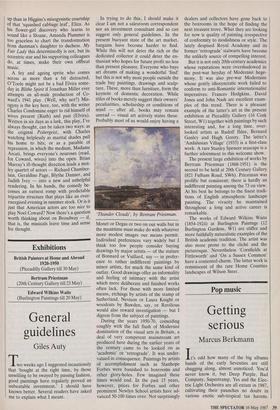Exhibitions
British Painters at Home and Abroad 1920-1950 (Piccadilly Gallery till 30 May) Bertram Priestman (20th Century Gallery till 23 May) Edward Wilkins Waite (Burlington Paintings till 20 May)
General guidelines
Giles Auty
Two weeks ago I suggested incautiously that 'bought at the right time, by those unwilling to be swayed by passing fashion, good paintings have regularly proved an unbeatable investment.' I should have known better. Several readers have asked me to explain what I meant. In trying to do this, I should make it clear I am not a salesroom correspondent nor an investment consultant and so can suggest only general guidelines. In the present buoyant state of the art market, bargains have become harder to find. While this will not deter the rich or the dedicated collector it could deter the en- thusiast who hopes for future profit no less than present pleasure. Everyone who buys art dreams of making a wonderful 'find' but this is not why most people outside the trade buy paintings, drawings and sculp- ture. These, more than furniture, form the keynote of domestic decoration. While titles of books merely suggest their owners' peculiarities, scholarship or conditions of mind — after all, books may remain unread — visual art actively states these. Probably most of us would enjoy having a 'Thunder Clouds', by Bertram Priestman.
Monet or Degas or two on our walls but in the meantime must make do with whatever more modest images our means permit. Individual preferences vary widely but I think too few people consider buying drawings by major artists — of the stature of Bonnard or Vuillard, say — in prefer- ence to rather indifferent paintings by minor artists, for much the same kind of outlay. Good drawings offer an informality and feeling of intimacy with the artist which more deliberate and finished works often lack. For those with more limited means, etchings by artists of the stamp of Sutherland, Nevison or Laura Knight or woodcuts by Bawden, say, or Ravilious would also reward investigation — but I digress from the subject of paintings.
During the years 1950-70, coinciding roughly with the full flush of Modernist domination of the visual arts in Britain, a deal of very competent mainstream art produced here during the earlier years of the century came to be looked on as `academic' or 'retrograde'. It was under- valued in consequence. Paintings by artists of accomplishment such as Stanhope Forbes were banished to boxrooms and other glory-holes. Few imagined these times would end. In the past 15 years, however, prices for Forbes and other prominent Newlyn School artists have ad- vanced 50-100 times over. Not surprisingly dealers and collectors have gone back to the boxrooms in the hope of finding the next treasure trove. What they are looking for now is quality of painting irrespective of conformity to modishness or style. The lately despised Royal Academy and its former 'retrograde' stalwarts have become the unlikely source of compelling interest.
But it is not only 20th-century academics whose reputations were overshadowed in the post-war heyday of Modernist hege- mony. It was also pre-war Modernists whose gently idiosyncratic work failed to conform to anti-Romantic internationalist imperatives: Frances Hodgkins, David Jones and John Nash are excellent exam- ples of this trend. There is a pleasant example of the latter's art in the present exhibition at Piccadilly Gallery (16 Cork Street, W1) together with paintings by such interesting and, for a long time, over- looked artists as Rudolf Ihlee, Bernard Ganley and Hugh Gresty. The latter's `Andalusian Village' (1933) is a first-class work. A rare Stanley Spencer seascape is a further adornment to this welcome show.
The present large exhibition of works by Bertram Priestman (1868-1951) is the second to be held at 20th Century Gallery (821 Fulham Road, SW6). Priestman was prolific but consistent; there is hardly an indifferent painting among the 73 on view. At his best he belongs to the finest tradi- tions of English atmospheric landscape painting. The vivacity he maintained throughout a long and active career is remarkable.
The works of Edward Wilkins Waite (1854-1924) at Burlington Paintngs (12 Burlington Gardens, W1) are stiffer and more faithfully naturalistic examples of the British academic tradition. The artist was also more prone to the cliché and the picturesque. Nevertheless 'Cornfields at Fittleworth' and 'On a Sussex Common' have a contented charm. The latter work is reminiscent of the rare Home Counties landscapes of Wilson Steer.




















































 Previous page
Previous page